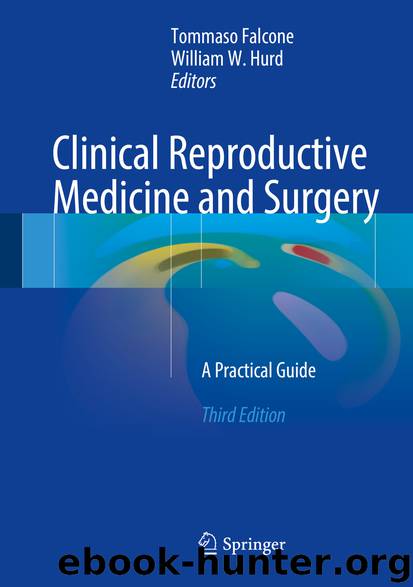Clinical Reproductive Medicine and Surgery by Tommaso Falcone & William W. Hurd

Author:Tommaso Falcone & William W. Hurd
Language: eng
Format: epub
Publisher: Springer International Publishing, Cham
13.21 Pharmacologic Protection
13.21.1 Gonadotropin-Releasing Hormone Agonists
The ideal approach to decrease or eliminate gonadal damage from chemotherapy is pharmacologic. The patient can take a medication and proceed with her cancer treatment without undergoing an invasive procedure. The critical step in the development of such a drug is an understanding on how chemotherapy actually causes ovarian follicle destruction. The impact, as stated earlier, depends not only on the type of chemotherapeutic agents but on age, ovarian reserve, dose, and duration of treatment. The unique feature of chemotherapy induced gonadal damage is the predilection towards damage of the primordial follicle, which consists of non-growing cells. Growing follicles are immediately impacted resulting in amenorrhea. Chemotherapeutic agents can directly cause apoptosis of follicles, with the dividing granulosa cells being particularly susceptible to damage [ 49 – 51 ]. This latter phenomenon leads to the theory of “follicle burn out” [ 49 ]. Since growing follicles have a direct effect in dampening the initiation of primordial follicle growth, the immediate and complete loss of growing follicles causes an accelerated recruitment of primordial follicles and a decrease in the total ovarian follicular reserve. In addition to these effects chemotherapy can cause stromal fibrosis and damage to intra-ovarian vessels. The ideal drug would impede these effects. Drugs that act on apoptotic pathways such as sphingosine-1-phosphate or drugs that impede follicle activation pathways such as AMH would be ideal. Most are in pre-clinical trials and not available clinically. While testing these drugs it is important not to interfere with the efficacy of the cancer treatment. The only drug clinically available for use in patients undergoing gonado-toxic treatment is Gonadotropin-releasing hormone agonists (GnRHa) .
Protection of gonadal function is more than just preservation of fertility. Many aspects of quality of life are related to gonadal function. Hypogonadal symptoms such as hot flashes, insomnia, vaginal dryness, dyspareunia, and impaired sexual function are equally important. Ovarian failure is associated with osteoporosis, cardiovascular disease, and neurocognitive decline. Therefore drugs that prevent chemotherapeutic damage can be efficacious in maintaining an estrogenic environment and quality of life without necessarily protecting fertility.
It is unclear how GnRHa can impede the gonadotoxic effects of chemotherapy. Its effect on suppressing the pituitary gonadotropin secretion is well described. This aspect of the drug cannot be solely responsible for its observed effects as primordial follicle activation is independent of gonadotropins. It may be acting on impeding follicle recruitment by different mechanisms [49]. GnRHa are thought to decrease vascularity at the level of the ovary, thereby reducing the concentration of chemotherapy acting directly on the ovary [49].
The use of GnRHa during chemotherapy is still a controversial and considered experimental. In some circumstances such as preventing the severe menstrual bleeding associated with some chemotherapeutic drugs it is quite effective. GnRHa can be useful for preservation of gonadal function to alleviate hypogonadal consequences. It seems to be more effective when used in conjunction with chemotherapy in breast cancer patients than lymphoma patients [52–54]. This may be due to the temporal relationship of the diagnosis and
Download
This site does not store any files on its server. We only index and link to content provided by other sites. Please contact the content providers to delete copyright contents if any and email us, we'll remove relevant links or contents immediately.
| Administration & Medicine Economics | Allied Health Professions |
| Basic Sciences | Dentistry |
| History | Medical Informatics |
| Medicine | Nursing |
| Pharmacology | Psychology |
| Research | Veterinary Medicine |
Tuesdays with Morrie by Mitch Albom(4692)
Yoga Anatomy by Kaminoff Leslie(4306)
Science and Development of Muscle Hypertrophy by Brad Schoenfeld(4089)
Bodyweight Strength Training: 12 Weeks to Build Muscle and Burn Fat by Jay Cardiello(3915)
Introduction to Kinesiology by Shirl J. Hoffman(3725)
How Music Works by David Byrne(3187)
Sapiens and Homo Deus by Yuval Noah Harari(2987)
The Plant Paradox by Dr. Steven R. Gundry M.D(2547)
Churchill by Paul Johnson(2506)
Insomniac City by Bill Hayes(2498)
Coroner's Journal by Louis Cataldie(2432)
Hashimoto's Protocol by Izabella Wentz PharmD(2331)
The Chimp Paradox by Peters Dr Steve(2297)
The Universe Inside You by Brian Clegg(2097)
Don't Look Behind You by Lois Duncan(2080)
The Immune System Recovery Plan by Susan Blum(2029)
The Hot Zone by Richard Preston(1983)
Endure by Alex Hutchinson(1964)
Woman: An Intimate Geography by Natalie Angier(1882)
